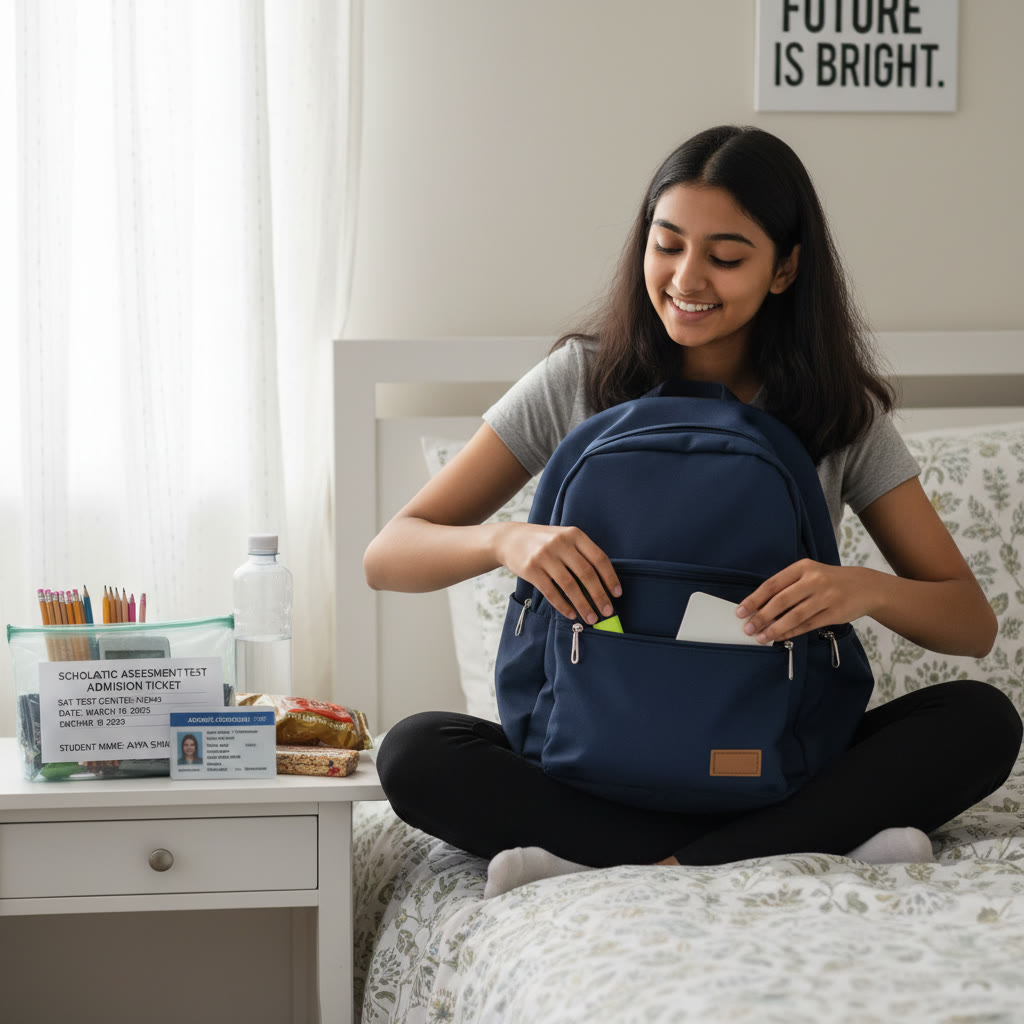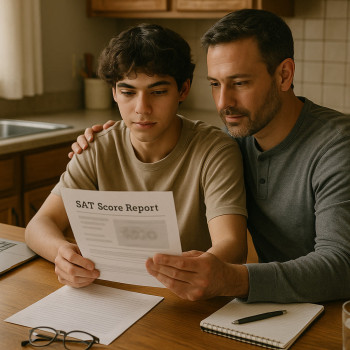Why the night before matters more than you think
The SAT is a marathon of attention and stamina as much as it is a test of knowledge. You can spend months sharpening math skills and polishing essays, but the night before the exam shapes how all that preparation shows up. A tired brain misreads questions, anxiety eats into your focus, and a skipped snack becomes an uncomfortable distraction. The night before is where nerves either get louder or are gently quieted. This guide isn’t about last-minute cramming. It’s about building a calm, practical routine that lets your best work surface the next day.
Small decisions, big impact
Think of the evening as a set of small choices stacked together: sleep or late-night scrolling; a balanced dinner or whatever’s quickest; breathing exercises or rumination. Each one nudges your nervous system toward calm or chaos. When you string together the right choices, you arrive on test day with steady attention, clear thinking, and the confidence to use the strategies you’ve practiced.
Mindset checklist: what to believe the night before
Your headspace the night before should be practical and kind. Here are five simple mental anchors to repeat to yourself when worry pops up:
- Progress over perfection: I’ve prepared. I don’t need to make yesterday’s studying perfect tonight.
- Focus on process, not outcome: I will use the strategies that work for me and take each question step by step.
- One decision at a time: I control my sleep, food, and calmness. Those are the decisions I make now.
- I’m allowed to be nervous—nervous energy can be focused into attention.
- I will be kind to myself. High pressure doesn’t mean harshness helps.
Short mental exercises to reduce spirals
- Label the worry: name it (“I’m worried about timing”), then set it aside for a fixed “worry window” tomorrow afternoon—don’t ruminate now.
- Mini gratitude: list three small things that went well in your prep—this shifts attention away from fear.
- Visual rehearsal: imagine walking into the test center calm, clicking your pencil, breathing, and reading the first passage with clarity.
Practical evening routine: a calm roadmap
Below is a sample timeline you can adapt to your schedule. The goal is predictable, low-stress structure that prioritizes sleep, nutrition, and a final low-pressure review.
| Time (example) | Activity | Why it helps |
|---|---|---|
| 6:00–7:00 PM | Balanced dinner: lean protein, complex carbs, vegetables, water | Provides steady energy and prevents late-night blood sugar dips |
| 7:00–8:00 PM | Light, focused review (30–45 minutes): flashcards or a short formula sheet | Refreshes confidence without creating new stress—no heavy cramming |
| 8:00–9:00 PM | Prep everything for the morning: pack bag, set clothes, gather ID and admission ticket | Removes decision friction and prevents last-minute panic |
| 9:00–9:30 PM | Relaxation routine: breathing, journaling, visualization | Signals the nervous system to wind down and consolidates emotional readiness |
| 9:30–10:30 PM | Wind-down: low-stimulation activities, dim lights, no screens when possible | Supports faster sleep onset and deeper rest |
| 10:30 PM | Lights out (adjust earlier or later based on your normal schedule) | A consistent sleep time helps memory consolidation and alertness |
These times are examples—adjust them around your normal routine. The key is to end the evening consistently so your body knows when to sleep.
Two image ideas


What to do—and what to avoid—in the evening
Do:
- Pack your bag the night before. Include extra pencils, a trusted calculator, batteries, acceptable ID, admission ticket, snacks, water, and a comfortable layer of clothing.
- Do a short, positive review—look at a formula sheet, a few vocabulary words, or a couple of strategy reminders (e.g., process of elimination techniques).
- Practice a relaxation routine that actually works for you. Keep it short and reproducible the next morning.
- Follow your normal sleep schedule. If you usually sleep at 11:30, don’t try to force an 8 PM bedtime; aim for quality and consistency.
Don’t:
- Crash through a full-length practice test. Performance pressure from an evening test can leave you wired or disappointed.
- Start a new study method or resource. New techniques can produce confusion and doubt.
- Use stimulants like excessive caffeine late into the evening—those can disrupt sleep architecture.
- Stay glued to screens for long stretches; blue light interferes with melatonin and makes it harder to fall asleep.
Relaxation techniques that actually work—short, science-backed practices
When anxiety rises, length sometimes gets in the way. Short, targeted interventions can shut down the physiological cascade of stress so your prefrontal cortex (the thinking part of your brain) can re-engage.
Box breathing (a 3-minute reset)
How to do it: inhale quietly for 4 seconds, hold for 4 seconds, exhale for 4 seconds, hold for 4 seconds. Repeat 4–8 times.
Why it helps: steady breathing signals safety to the nervous system and slows the heart rate.
Progressive muscle relaxation (7–10 minutes)
- Tense a muscle group (e.g., fists) for 5 seconds, then release and notice the sensation.
- Move through hands, forearms, shoulders, neck, chest, abdomen, legs, and feet.
- This practice reduces physical tension and improves body awareness before sleep.
5-minute visualization script
Close your eyes and imagine the test center door. See yourself walking calmly, show your ID, and sit down. Picture reading the first question slowly and finding the path forward. If your mind wanders to fear, gently bring it back to the next breath. Finish by naming one thing you will do if you feel stuck (e.g., skip, mark, and return).
Journaling prompt to get worries on paper (5–10 minutes)
Write for five minutes: list everything on your mind about the test, then write a brief action next to each worry (for example: “timing—practice skipping tough questions and returning”). The act of writing reduces the brain’s need to rehearse those worries mentally.
Sleep: timing, quality, and common sense
For teenagers and young adults, 7–9 hours of sleep is generally recommended to support cognitive performance. It’s normal to feel some pre-test restlessness, but aim to give your brain the best environment for rest.
Practical sleep tips
- Keep lights dim an hour before bed. Lowering light tells your brain it’s time to wind down.
- Avoid screens or use a blue-light filter if you must use devices. Better yet, read a physical book or listen to a quiet podcast.
- Create a short pre-sleep routine: wash your face, change into comfortable clothes, do two minutes of box breathing, and turn off lights.
- If you struggle to fall asleep for more than 30 minutes, do a low-stakes activity in dim light—read a few pages, then try sleep again.
What if you sleep poorly?
One bad night won’t erase months of preparation. If you wake up after a restless night, use grounding techniques in the morning: splash water on your face, walk outside for 5 minutes, eat a simple carbohydrate + protein breakfast, and remind yourself that mental clarity often returns once you begin the test and settle into rhythm.
Fuel for the brain: dinner and breakfast ideas that support steady focus
The right combination of carbohydrate, protein, healthy fat, and hydration keeps blood sugar steady and reduces mid-test distractions.
| Meal | Example | Benefit |
|---|---|---|
| Dinner | Grilled chicken, brown rice, roasted vegetables, water | Sustained energy without heaviness |
| Evening snack (if needed) | Greek yogurt with berries or a small banana with peanut butter | Protein + carbs keeps you full and stabilizes blood sugar |
| Breakfast (test morning) | Oatmeal with banana and almond butter, or eggs with whole-grain toast, and water | Slow-release energy to power attention for the first sections |
Hydration
Drink water steadily in the evening and a modest amount in the morning. Avoid downing a large amount right before the test so you aren’t distracted by frequent restroom trips. A small bottle of water for breaks is a great idea.
Morning-of essentials: low-stress checklist
On the test morning, aim for a calm, consistent routine that reduces decision fatigue.
- Wake up with enough time to move slowly—no rushing. Give yourself 60–90 minutes from wake to leaving if possible.
- Eat the breakfast you’ve planned and practiced on shorter runs—don’t try a new food.
- Dress in layers. Testing rooms can be unpredictable in temperature.
- Pack the bag you prepared the night before and do one last glance at your quick strategy sheet (no heavy studying).
- Plan to arrive early. Aim for 45–60 minutes before the center opens check-in. This cushion reduces surprises.
Morning mental routine
Start with 30–60 seconds of box breathing, then a short pep phrase you trust—something specific like, “I read carefully; I manage time.” Keep the language short and actionable. If nerves spike, use grounding: name five things you can see, four you can touch, three you can hear, two you can smell, and one you can taste.
When worry tempts you to cram: a gentle plan
It’s normal to feel a last-minute itch to open a practice test or memorize a list. If you must review, keep it sharply limited.
- Set a 20–30 minute timer for a final review—no more.
- Focus on a tiny set of actionable strategies: how to handle hard reading questions, a geometry formula you sometimes forget, or timing checkpoints for each section.
- Create an “I will do” list—three tactical moves you can make during the test (for example: skip after 2 minutes on a hard problem; underline the author’s tone in passage questions; eliminate obviously wrong answers first).
How to use support—teachers, parents, and tutors—without increasing pressure
Help is a huge asset, but it can feel intense if it turns into last-minute micromanagement. Make requests specific and brief. Instead of “help me with everything,” ask for a calm checklist read-through, a five-minute breathing session together, or a quiet ride to the test center. If you’ve been using a tutoring service, keep exchanges low-key the night before.
For example, if you’ve worked with Sparkl’s personalized tutoring and benefits—1-on-1 guidance, tailored study plans, expert tutors, AI-driven insights—you might ask your tutor for a 10-minute calming script or a single-page “do-not-forget” checklist. Those tailored supports are perfect for trimming anxiety without adding new content to master.
Quick troubleshoots for common night-before problems
- No desire to sleep? Try a 10-minute walk in fresh air, then a wind-down routine with no screens.
- Feeling like you didn’t study enough? Remind yourself that consistent studying over weeks matters more than one evening. Use a 20-minute review if it helps, then close the books.
- Worried about logistics? Check on the testing center’s location, transportation, and parking tonight. Make a backup plan for arrival.
- If caffeine has been part of your training, stick with the amount you’re used to—don’t experiment with more or less right before test day.
Real-world examples: how different students approach the night before
Two short examples show how varied reasonable routines can be. Both students performed well because they focused on calm routines, not dramatic last-minute study binges.
Priya: the routine-driven student
Priya followed her usual evening schedule. She ate a familiar meal, packed her bag, and spent 20 minutes reviewing a one-page strategy sheet she developed with her tutor. Her tutor reminded her of two calming breaths to use between sections. Priya slept nine hours and woke up feeling steady—she credited the predictability for her sharp focus.
Marcus: the anxious crammer who learned to let go
Marcus felt panicked the night before and started a relentless question loop. He tried a short journal exercise and set a 25-minute timer for a final review of vocabulary. Then he did 10 minutes of box breathing before bed. The result? Less tension and an ability to concentrate during the reading section without revisiting every word he’d studied.
Final words: control what you can, and let the rest go
The night before the SAT is not an opportunity to create a miracle score through frantic effort. It’s an opportunity to step into the exam calm, rested, and organized so the skills you spent months building can come forward. Prioritize good sleep, steady meals, a short checklist review, and gentle relaxation. Pack your bag. Practice two breathing patterns. Say one encouraging sentence to yourself and then—just for tonight—permit rest.
On test day you’ll rely more on steady attention than raw knowledge. Give yourself the best conditions to be steady.
And if you want an extra shield of confidence, consider getting one last brief plan from a trusted mentor. Tutors who offer 1-on-1 guidance and tailored study plans can help you identify the one or two small moves that will keep you calm and effective without adding pressure. If you’ve used Sparkl’s personalized tutoring and benefits—expert tutors and AI-driven insights—lean on the simple checklist they helped you create.
Checklist: night-before and morning-of
- Pack: admission ticket, acceptable ID, extra pencils, eraser, calculator with extra batteries, watch (non-smart), snacks, water, sweater.
- Finalize: directions, transportation plan, comfortable clothing laid out.
- Short review: 20–30 minutes max of strategy reminders or a one-page sheet.
- Relax: 10 minutes of breathing or progressive muscle relaxation, 5 minutes of journaling if needed.
- Sleep: aim for your normal sleep window—7–9 hours if possible.
- Morning: simple breakfast, hydration, arrive early, use a short breathing routine before the test begins.
You’ve prepared. Tomorrow is about executing the plan you’ve already built: steady reading, methodical thinking, and calm decision-making. Trust the process, practice the small rituals above, and remember—this one test is a single step on a much larger journey.
Good luck. You’re ready.














No Comments
Leave a comment Cancel